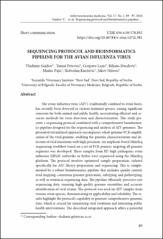Sequencing protocol and bioinformatics pipeline for the avian influenza virus

View/
Date
2024-06Author
Gajdov, Vladimir
Petrović, Tamaš
Lazić, Gospava
Đurđević, Biljana
Pajić, Marko
Knežević, Slobodan
Nišavić, Jakov
Metadata
Show full item recordAbstract
The avian influenza virus (AIV), traditionally confined to avian hosts,
has recently been detected in various mammal species, raising significant
concerns for both animal and public health, necessitating efficient and accurate
methods for virus detection and characterization. This study presents
a sequencing protocol combined with a comprehensive bioinformatics
pipeline designed for the sequencing and analysis of AIV genomes. The
presented streamlined approach encompasses whole genome PCR-amplification
of the viral genome, enabling the genome characterization and detection
of viral mutations with high precision. An amplicon-based MiniSeq
sequencing workflow based on a set of PCR primers targeting all genome
segments was developed. Three samples from H5 high pathogenic avian
influenza (HPAI) outbreaks in Serbia were sequenced using the MiniSeq
platform. The protocol involves optimized sample preparation, tailored
specifically for AIV, library preparation and sequencing. This is complemented
by a robust bioinformatics pipeline that includes quality control,
read mapping, consensus genome generation, subtyping and pathotyping,
as well as statistical sequencing data. The pipeline efficiently processes raw
sequencing data, ensuring high-quality genome assemblies and accurate
identification of viral strains. The protocol was used on AIV samples from
various avian species, demonstrating its applicability and reliability. The results
highlight the protocol’s capability to generate comprehensive genomic
data, which is crucial for monitoring viral evolution and informing public
health interventions. The described integrated approach offers a powerfultool for AIV surveillance and research, facilitating timely and informed
decision-making in response to avian influenza outbreaks. This protocol
can be readily adapted for use in various laboratory settings, contributing to
global efforts in combating avian influenza and enhancing our understanding
of its genomic landscape.
